#museum of degenerate art
Explore tagged Tumblr posts
Text
Why are We so Scared of Reality?
You know the January insurrection was the first time the Confederate flag was EVER flown in the capital, right?
Surly breaking into a government building, killing people, and flying the flag of a hate group, counts as terrorism, right?
You know people celebrated the death count that day, right?
Why are we not talking about it? Why do we not talk about domestic terrorism? What are we so afraid of? Why is it better to act as if it was all a dream, than to face reality?
Why are we so scared of Red, Yellow, and Blue?
#politics#us politics#world politics#january 6#tw terrorism#cw terrorism#art#art history#museum of degenerate art
7 notes
·
View notes
Text


#absolutely fascinating experience reading that plaque and going. yup. I've heard allllll of that almost word for word.#and then looking at the painting#that? is what you're so upset about?#producing and celebrating art that some will call degenerate is inportant#and who knows. maybe in 100 years it will be just a kind of boring painting in a world famous museum#not calling The Bather boring I'm just saying it's not at all shocking to modern audiences#ANYWAY much to think about. many thoughts.#it is important to protect the weird and uncomfortable and the countercultural
1 note
·
View note
Text
"Traditional European ArchitectureTM is the best! modern architecture is degenerate!"
"alright, well, putting aside my strong disagreement on the philosophical/ethical undertones of your statement- I do love old buildings! you must be a big proponent of paid apprenticeships for preservation students"
"um what?"
"well, people have to know how to preserve these buildings. and as it stands now, only those willing to go into student debt or with family money to fall back on while they study can afford to learn the techniques involved (unless they're lucky enough to be born into a family with their own preservation contracting business). young people aren't going into these fields even if they want to, because they can't take the financial hit"
"yes but why should anyone have to pay them to learn? they should pull themselves up by their bootstraps!"
"...right. well, what about preservation grants? nationalizing historical site museums?"
"government handouts! no way!"
"preserving and revitalizing traditional forms of building craftsmanship, like decorative masonry or plasterwork, stained glass, tiling, clockmaking, etc?"
"those things cost too much and will hurt the building company's bottom line!"
"talking about the people whose labor made these incredible works of architectural art possible?"
"woke history!"
"adaptive reuse, like letting businesses rent historical buildings with appropriate restrictions on modification?"
"ew! not in my backyard!"
"traditional buildings in styles from other parts of the world?"
"no, no, no! everyone knows western art is the most ~highly evolved~!"
"so, let me get this straight: you just want grand old buildings to be there, and stay perfectly intact, unused for anything, with no effort whatsoever. and you want new buildings to happen in that style but somehow as cheaply as throwing up a glass-and-steel skyscraper that starts falling apart in six months? also only western-style buildings, and we should only talk about very specific people who occupied them?"
"yes!"
"my guy, you don't actually love old architecture"
#architecture#old buildings#if contractors were willing to pay more for decent and decorated construction#or billionaires valued young people learning these skills so they don't die out#we might have modern buildings in that style- in ANY traditional style the world over -and we'd be able to save more of them#they also don't want to talk about how builders and other architectural craftspeople have a history of strong collective action#going back to medieval guilds#(also of course all of this is thinly-veiled racism)#(they don't really care about the architecture)
183 notes
·
View notes
Text
ketterdam dashboard simulator

goedmedbridge420
who up boeking they canal
10,345 notes

drydens follow
I can't believe some of you log on here and thirstpost about barrel vagrants. it makes me so sick. these men are the very pits of society and have never honoured ghezen a day in their lives. there are so many other young men who make their living in a reverent way. have some dignity.
#ghezen #inghezenssight #ghezenhonouring #churchofghezen #handofghezen
2 notes

kooperomno1fan
lionsroar12 follow
omg HOW is kaz brekker winning this he's SO problematic he's not even good for the economy he killed members of his own gang and kidnapped councilman van eck's son
dregsundrained
cranky coz your gang fell apart aren't you
17,860 notes

oskervoexchange follow

guys is this a mandela effect or what bc I SWEAR this painting used to be in the university district art museum, I literally saw it this week??? but I went today and it was GONE?????? there wasn't even a plaque?? guys pls I'm so confused why is everyone acting like this is normal for ketterdam? do priceless antiques just VANISH? am I being gaslit?
450 notes

stadhall-clerking
guys I'm so sorry I've been MIA :( I found out that my landlord was using my rent on the staves rather than fixing my black mould problem so I pushed him out the window and told the stadwatch he must have fallen and died because he wasn't honouring ghezen and got away with it. anyway I think maybe the black mould explains the dirtyhands/sturmhond fic I was writing sorry :( but I WILL finish my fairy queen of istamere meta post once I've moved into my new lodging
670 notes

dregsconfessions follow
SUBMISSION: sometimes I lie awake thinking about the time I fell down an entire flight of stairs at the slat when kaz was at the bottom, and he just stared at me (still lying on the floor), and then asked if I'd changed the beer kegs at the silver six yet. GIRL NO?!?!?!
#submission #dregs #dirtyhands #admin comment: laughed so loud my upstairs neighbour threatened to shoot me
546 notes

dregsconfessions follow
ADMIN NOTE: if the razorgulls don't fucking stop sending anon hate to this blog we'll tell dirtyhands n he'll send you your own IP address back
#see what happens you hack job seagulls
500 notes

kerchtourismboard
it's us, the real kerch tourism board, here to tell you what we're putting in the new summer season pamphlet. we got 1) three pages all about kaz brekker that end up being more of an advertisement than a deterrent 2) list of slipperiest spots in the barrel where you will fall over and get a concussion when ur drunk 3) top 10 ways to get your wallet stolen by a child in broad daylight 4) paintings of the komedie brute 5) advert for sten's stockpot 6) map of public toilets
570 notes

kerchtourismboardreal follow
we are not affiliated with any degenerate impersonator accounts who claim to be us. we are the only real kerch tourism account.
23 notes

kerchtourismboard-real follow
grafcanal smells like piss and you should bite everyone you see wearing the mister crimson costume
450 notes

stensstockpot follow
it's all 'fuck sten's stockpot' and 'I got food poisoning from the special at sten's stockpot' until you realise you don't have the money for cilla's fry, and then you come CRAWLING back to the loving arms of sten's stockpot and our special. you fucking traitors. you'll be back! you'll all be back
canaljumpings follow
what's in the special sten's stockpot
stensstockpot follow
it's a surprise ;)
bertskerch follow
nah I thought this was the real stens lmao
stensstockpot follow
bert smit you still have 45 kruge to pay on your tab and if you don't cough up we'll send our debtors to break your legs
230 notes

exchangingbabey follow
my grisha girlfriend who still wears a kefta and says things like 'nikolai lantsov is a bastard': ugh they're still debating whether or not the council of tides should be able to control kerch shipping, I hate inter-country politics
me: I think I hauve the queen's lady
4500 notes

(insp) (insp)
#I wasted a full hour making this#six of crows#crooked kingdom#soc duology#kaz brekker#ketterdam#soc#grishaverse#shadow and bone#my post#dashboard simulator
1K notes
·
View notes
Text

Paul Gangolf (German, 1879 - murdered 1936) was born on this day. "Tightrope Walker", c. 1925-30, lithograph, hand-colored with transparent watercolor. National Gallery of Art, Washington DC. Born to a Jewish family, Paul Loewy changed his name to Gangolf in the 1900s. Hamburg collector Gustav Schiefler acquired his sketches, as he had previously done for Ernst Ludwig Kirchner, Max Liebermann and Edvard Munch, among others. In 1926 Gangolf moved to Paris where he took part in art exhibitions. After the Nazi party took power, Gangolf was arrested as a result of a denunciation on the streets of Berlin, spent several months in the Columbia-Haus concentration camp and then deported to the Esterwegen concentration camp, where he was shot. In 1937, as part of the “Degenerate Art” campaign, Gangolf's paintings were confiscated from all museums and collections. Most were destroyed.
69 notes
·
View notes
Text
Okay here's a bit more of the Cosmic PT cast, introducing Cosmic Pepperman and Cosmic Vigilante.
One small thing before we start ☝️, these are what you can define as "beta" designs, as you can see by the fact it's neither colored or digital, I just want to share those to hear some feedback and possible fresh ideas to make those designs better. Also because I want to share what they do and what is specific about them story wise. Until I say explicitly that I'm done with the design, keep in mind that they might change overtime. With that being said let's get to it!
And here's Cosmic Pepperman,

currently at the very end of the minor cosmic stage and one of the most experienced cosmic entity of the PT cast who's still around. Phil mostly plays solo and loves to show off when he intervenes in a universe, when he's here you know you're about to see a performance of quality 👌. Although sometimes his attempt at throwing shades and look cool falls flat and he can make a fool out of himself... But no matter what happens he always manages to save the day before disappearing Meta Knight style using his long jacket as a cape.
Meanwhile in the cosmic realm, Phil still is a freelance artist, showing off his art in his own museum in Cosmopolis's center. Before Cosmic Noise appeared, Phil's museum was one of the most popular and visited place of the realm, after NNS took over the public, the museum lost of it's glory and became another building among others with very few visitors. Ever since that, Phil holds a pretty big grudge toward Cosmic Noise, boycotting his show and just being generally annoyed at C Noise's presence.
For Pepperman's design I got inspired by his costume of the Halloween update and slitly exaggerated it to make a long flowy jacket. Also I gave him small star shaped shades because shades and Pepperman are just MEANT to be together, the star shape is just to stay consistent with the Cosmic theme (very thought out eh 👁️👄👁️👍), and finally one of my favorite aspect of his design is his scar across his face of which he wears with style ✨✨✨.
Now beware, here comes Cosmic Vigilante

Also at the very end of the minor cosmic stage, one the most experienced of the cast and the most efficient at his job. Vigi really puts his heart when doing his tasks, being very serious and making sure that everything goes back to normal, as if nothing happened. He also is the stealthiest entity of the cast with very little people to have ever noticed him in his whole carrier.
In the Cosmic realm, Vigi doesn't really have a job, his only job is to fix any anomalies in the multiverse so he just uses his time in the realm to have a break, take a coffee, going for a stroll or hang out with friends.
For the Vigilante's design, I barely changed anything, his hat is different with the edge going slitly up in flames, the only note worthy detail is his left eye of course, his scar is hidden by a very bright star, a star with the very cool effect of giving it's owner future vision, it only predicts things 10 seconds max before they happen, but it is still a formidable advantage.
Together, Pepperman and The Vigilante are a very efficient cosmic duo, over time they grew a very good relationship and learn how to work with each other. When joined together, they're very professional (in most cases) and really forged a reputation among cosmic entities.

And now is time for :
Random trivia ✨✨✨
Because I don't know how to write a sentence
Very few people knows about Vigi's future vision, only some members of the PT cast does, if the court comes to know about it, Vigi WILL get in trouble.
Pepperman kept his ability to bring his art to life after becoming a cosmic entity, he might be the only being of the realm capable of breathing life into inanimate objects (assuming that his art are conscious beings with free will and not puppets Pepperman controls somehow)
Both Pepperman and Vigilante's memories degenerated to the point they can't remember the people they once knew, they only remember experiences of their past life but not the people that participated in those experience.
The Vigilante's mode of transport is his hat ! He gets inside of it and morphs it into an UFO (with a gyrophare occasionally when he's on the hunt for an outlaw) , the hat gets transparent and you can see him all squished up inside his hat.
Cosmic Vigilante is aware that he's a cheese slime, which was a huge shock when he figured it out
When disappearing "Meta Knight style" Phill doesn't actually disappears, he just trows his jacket in the air and spins it to get people's attention while he runs as far and fast as possible into the distance, he runs until he reaches the edge of the universe and only after that he gets back to the cosmic realm.
And yeah that's it ! Thank you for reading! As always if you have any questions go ahead and ask, I'll be glad to answer.
85 notes
·
View notes
Text

Otto Dix Kriegskrüppel (War Cripples) 1920
The Otto Dix painting, "Kriegskrüppel," was purchased by a German museum shortly after it was originally displayed. After the Nazis came to power, they pulled it, and many other works of art they had disdain for, out of the museums. Some of those artworks they found most distasteful were displayed in the infamous "Entartete Kunst" (Degenerate Art) exhibit, which toured German cities in 1937. These artworks were displayed in such a way that the Nazis hoped they would encourage broad social revulsion for modern art, which they considered Jewish, Bolshevik and otherwise antithetical to the new "German" spirit they were trying to instill in people. Many of the displayed artworks, Kriegskrüppel inscluded, disappeared after the Entartete Kunst exhibit closed, and it's assumed the fascists destroyed them. Kriegskrüppel is known only from a few prints made in the image of the original painting.
98 notes
·
View notes
Text
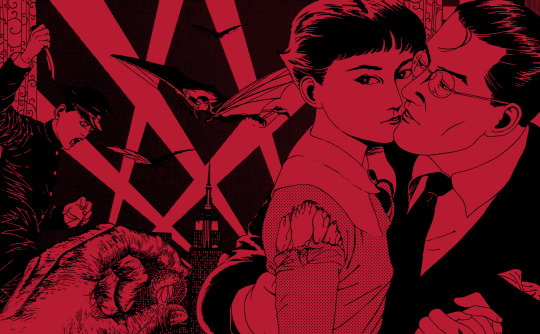
The Post-Futurist Fossils of LITCHI HIKARI CLUB In a somewhat recent research tangent, while considering the possible “genealogy” of the Tokyo Grand Guignol’s themes and aesthetics, I made an interesting personal discovery regarding Litchi Hikari Club. Specifically some distinct thematic parallels that the play shares with the Italian futurist movement, less in relation to the art of the movement itself, but rather the ideologies of the movement’s controversial founder, Filippo Tommaso Marinetti, and his relation to the Italian fascist party. This is all of course in the context of understanding Litchi as a transgressive/dystopian horror story. This is less of an absolute statement than it is a sort of open train of thought, so take things with a fair grain of salt. This is more or less just my own personal analysis of all the materials I could gather of the original play. Beyond inspecting the play as a possible allegory for futurism, there's also just a lot of general analysis of the play in relation to Ameya's overall body of work, both with the Tokyo Grand Guignol and also as a performance artist. I rarely put a 'keep reading' tag on these things since I'm an openly shameless product of the early days of blogging, but this one's a doozy (both in the information but also just the gargantuan length). Hopefully others will find it just as interesting. The full essay is below...
The futurist movement itself was nothing short of an oddity. In their time, the futurists were pioneers of avant-garde modernist aesthetics, with their works ranging from deconstructive paintings to reality-bending sculptures and even early pathways to noise music with the creation of the non-conventional Intonarumori instruments of Luigi Russolo. Russolo’s own futurist-adjacent manifesto, The Art of Noises, would go on to influence such artists as John Cage, Pierre Henry, Einstürzende Neubauten and the openly left-wing industrial collective Test Department. When visiting the MOMA in New York City as a child, I was fascinated by Boccioni’s Unique Forms of Continuity in Space, a sculpture that appeared to be a spacetime malformation of the human figure encapsulated in a continual state of forward motion while in total stillness. Despite this, the futurists were also a social movement of warmongering misogynists, with their own founding manifesto by Marinetti describing the bloodshed and cruelty of war as being “… the only cure for the world”. Their manifesto would also feature quotes such as “We want to demolish museums and libraries, fight morality, feminism and all opportunist and utilitarian cowardice”. They would originally pin anarchism as being their ideological ground in the manifesto, but shortly thereafter Marinetti would pick up an interest in fascism along with the politics of Benito Mussolini, going on to be a coauthor for the Italian fascist manifesto alongside the futurist manifesto. In consideration of how throughout most of World War II, modernist and post-modern works were considered “degenerate” forms of art in contrast with traditionalism, a whole avant-garde movement founded from fascist ideals is paradoxical. But for a period of time, that parallel wasn’t only in existence, but backed by Mussolini himself with there being a brief effort by Marinetti to make futurism the official aesthetic of fascist Italy. One of the draws of futurism for Marinetti was an underlying sense of violence and extremity. According to Marinetti, his initial inspiration for the movement was the sensations he felt in the aftermath of a car accident where he drove into a ditch after nearly running over a band of tricyclists. He conceived his works to be acts of social disruption, intending to put people in states of unrest to cause riots and similar bouts of violence. “Art, in fact, can be nothing but violence, cruelty, and injustice”. He sought to destroy history to pave the way for a rapid acceleration to futuristic technological revelation.

“As shown in Edogawa Rampo’s Boy Detectives Club, young men like to hide from a world of girls and adulthood to form their own secret societies.” - June Vol. 27 In Litchi Hikari Club, a group of middle school-aged boys are faced with a crisis on the brink of puberty. At the twilight of their childhoods, they form a secret society known as the Hikari Club (or Light Club), a collective that’s devoted to the active preservation of their shared youth and virginity. The boys naively mimic an authoritarian organization and its hierarchy as they seek a means to preserve their boyhood, which they see as being idyllic in contrast to adulthood, a dreary state of existence that they call old and tired in the Usamaru Furuya manga version of the story. Similarly, in the Litchi Hikari Club-inspired short manga Moon Age 15: Damnation, the boys go on to liken their hideout with the paradisiacal garden of Eden. In said story, Zera would directly name the poem Paradise Lost in reference to the discovery of their hideout by adults (arriving in the form of ground surveyors) and the wide-eyed daughter of a land broker, with their contact to the virgin industrialized land being an ideological tainting of the sacred lair. In their mission, they seek refuge in technological inhumanity by having their penises replaced with mechanized iron penises, symbolic devices of power and violence that can only procreate with other items of technology. Working in absolute secrecy, they collectively manufacture a robot known as Lychee. The purpose of Lychee, previously only known to Zera, isn’t revealed to the other club members until its completion. It’s when they unveil their “cute” robot in a scene that parallels the 1920 German expressionist film The Cabinet of Dr. Caligari that Zera tells the other members of Lychee’s purpose as a machine that would kidnap women for them. The robot's efforts are assisted by the girl capturing device, a strange rice cooker-shaped mask that’s laced with a sleeping drug. When questioned about the fuel source for the robot, Zera explains how it will run off the clean fuel of lychee fruits rather than an unsavory yet plentiful substance like electricity or gasoline as a means to further match the robot’s perceived beauty.
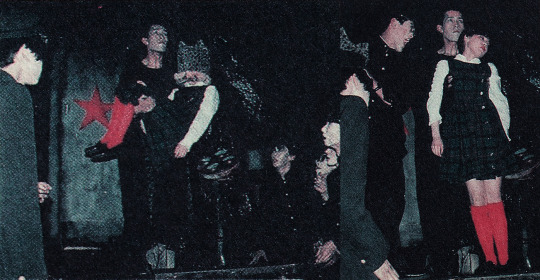
While the club share a general disdain for adulthood, they hold a special hatred to girls and women. Going off the dogmatic repulsion to sexuality that Kyusaku Shimada shows as the teacher in the Tokyo Grand Guignol’s prior play, Mercuro (1984), it could be assumed that the Hikari Club hold a similar dogmatic viewpoint about the vices of sex. In this context, it’s likely that they would’ve perceived women as being parasitic by nature as spreaders of the “old” and “tired” adult human condition through pubescent fixation and procreation. Sexual thoughts are inherent to aging for most people, given the process of discovering and exploring your identity throughout puberty. It’s that exact pubescent experience the club seek to eradicate. Further insight is given to the Hikari Club’s dystopian psyche through their open allusions to nazi ideology. While Zera travels out to gather lychees from a tree he planted, the club get a special visit from a depraved elderly showman known as the Marquis De Maruo, performed by none other than Suehiro Maruo himself in the 1985 Christmas performance. Despite the club’s disposition to adults, they hold an exception for the Marquis for his old-timey showmanship and open pandering to the children’s whims. He always comes with autopsy films to show the young boys, and as they watch the gory videos he hands out candies that he describes as being a personal favorite of the late Adolf Hitler. He was said to also be the one to convince the boys to name their robot after the lychee fruit. It isn’t until Zera returns that the Marquis is removed from the hideout on Zera’s orders. Just before his exiling, he foretells to Zera the prophecy of the black star as both a promise and a warning to the aspiring dictator. It should be noted that there is a fascist occult symbol known as the black sun.

Suehiro Maruo as the Marquis De Maruo. On the right side is a caricature of Maruo as drawn by a contributor to June magazine, excerpted from an editorial cartoon in June Vol. 27 covering Litchi's 1985 Christmas performance. In addition, the Marquis’ role alongside Jaibo’s appearances in the play (which I’ll get to later) show distinct parallels with the presence of the hobo in the Tokyo Grand Guignol’s first play, Mercuro. In Mercuro’s case, the hobo (performed by Norimizu Ameya, who would go on to also act as Jaibo) visits the classroom in secrecy to lecture the students his depraved ideologies. Whilst the hobo in Mercuro was a figure of perversion that existed in contrast to the teacher’s paranoid conservatism, in Litchi both Jaibo and the Marquis are enablers of the club’s fascistic leanings, with the Marquis being a promoter whereas Jaibo is a direct representation of the underlining perversions of fascist violence. Though completely omitted from the Furuya manga, the element of the autopsy films shines a unique light on Zera’s death at the end of the story. In both the play and the manga, Zera is gutted alive by Lychee when the robot undergoes a meltdown after being forced to drown Kanon (Marin in the original play) in a coffin lined with roses. In the manga, Zera appears deeply unsettled when realizing his intestines resemble the internals of an adult. It’s unknown if this aspect is present in the theater version, as the full script remains unreleased to this day. It would fit however knowing not just the club’s repulsion to adulthood, but also how they retreat to technological modification to eradicate the human aspects they associate with adulthood. What is described of Zera’s death in the theater version has its own disquieting qualities as, from what’s mentioned, when confronted with his own mortality he appears to regress to a state of childlike delirium, a demeanor that’s drastically different from his usual calm and orderly presentation. Upon seeing his intestines, one of the responses he is able to muster is “I’m in trouble”. He says this as he questions whether or not he can fit his organs back inside the cavity before eventually telling himself that he’s just tired, that he “need(s) to sleep for a while”.

While never directly stated, it’s heavily implied that the club’s ideologies and technological fetishism ultimately root back to Jaibo, an ambiguously European transfer student who secretly manipulates the club’s actions from behind the scenes. Referred to by Hiroyuki Tsunekawa (Zera’s actor) as the “true dark emperor” of the Hikari Club, he was said to haunt the stage from the sides, closely inspecting the Hikari Club’s activities while keeping a distance. The iron phallus was first introduced by Jaibo through a monologue where he reveals how he fixed one to his own person, carefully describing its inner mechanisms and functionality before demonstrating its inhuman reproductive qualities by using the phallus to have sex with a TV. A television that he affectionately refers to as Psychic TV Chan, in reference to the post-industrial band fronted by Genesis P’Orridge. In the same scene, he promises the other members that they would all eventually get their own iron penises just like his own. In a subsequent scene, he reveals the iron phallus’ use as a weapon when, arriving to the club’s base with a chained-up female schoolteacher who accidentally discovered the sanctuary, he uses the device to brutally kill the teacher through a mocking simulation of sexual intercourse. Just before raping her, he likens her to a landrace, bred for the sole purpose of reproducing and being processed into meat for consumption. He menacingly tells her that he will make her as “cut and dry” as her role in society before carrying out her execution. While there was some confusion on whether or not the iron phallus was a machine or solely a chastity device, it was found in bits of dialogue that the iron phallus at least shares the qualities of a pump with a described set of rubber hinges. The teacher’s death gruesomely reflects the death of Kei Fujiwara’s character in the later film Tetsuo: The Iron Man (1989), with the iron phallus mangling her insides as blood splatters across the stage. While the club treats adult sexuality as a plague, they manage to find through the iron phallus a way to convert their own states of chastity into a form of violence, stripping all humanity away from the penis and rendering it to a weapon of absolute power through desolate mechanized cruelty.
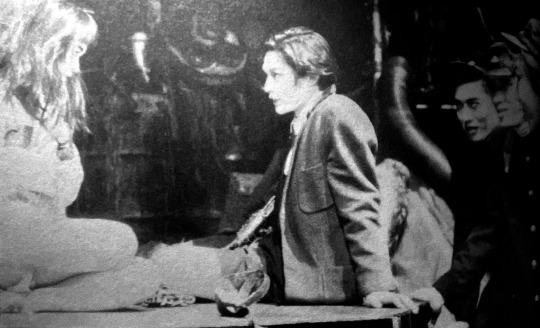
JAIBO: “Length, 250 mm, with a weight of 2.4 kilograms. Arm diameter, 30mm. Cylindrical thrust, 170mm… With pins, plates and rods of die-cast alloy. And hinges of rubber… the rest is pure iron. It is the iron phallus.” - June Vol. 27 In the same interview, Tsunekawa would go on to recall how the members of the Hikari Club were effectively Jaibo’s guinea pigs. In both the play and the manga, an after-school night of the long knives ensues with the slow collapse of the Hikari Club as Jaibo influences the exiling of certain club members, with Zera left ignorant to the social engineering as a mere extension of Jaibo’s elaborate puppeteering. Left embittered by a chess match where he lost to Zera, Tamiya is easily tricked by Jaibo into burning the lychee field as a way to get vengeance. Upon being caught, Tamiya is castrated of his iron phallus, resulting in his exiling from the club as a traitor while also being mockingly likened to a woman in the process. In another scene, it’s recalled that Jaibo and Zera exchange a conversation about the Hikari Club’s loyalty to Zera as they observe the outside world through their periscopes. By all contemporary recollections, Jaibo was the club’s puppet master. He would’ve been the likely source of the club’s ideologies, the underlining hatred to women and fixation on technological violence, replacing mankind with a race of humanoid weapons. Zera would be a shell without his influence. The presence of futurism could arguably even be rounded down to Lychee’s presence in the story. Beyond his theoretic work, Marinetti was also a playwright. He would be most well known for his futurist drama La donna è mobile, a story riddled with similarly perverse renditions of sexual violence. The play notably featured the presence of humanoid automatons a full decade before the term “robot” would be coined by Czechoslovakian author Karel Čapek in the play R.U.R., with the French version of Marinetti’s script referring to the machines as “puppets” for their visual similarity to humans.
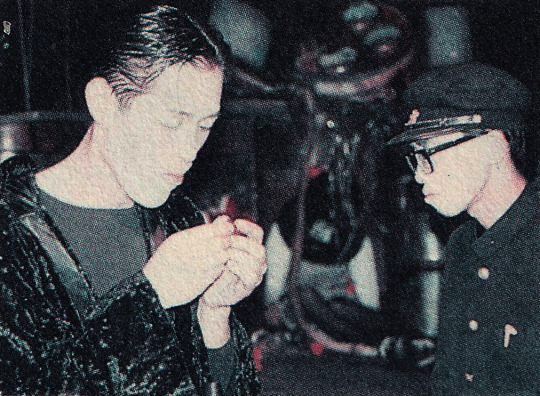
All of this plays out over a soundscape that’s dominated by unnatural electronic frequencies and synthesized percussion. The sound design was arguably one of the most important aspects of Ameya’s plays, with Ameya at one point describing the Tokyo Grand Guignol productions as being an ensemble of his favorite sounds. The setting further compliments the atmosphere, made to resemble the internal of a junkyard or factory warehouse where heaps of technical jump decorate the stage around the monochrome cabinet that would eventually birth Lychee. Some of the featured artists in the play’s first act include Test Department, The Residents, 23 Skidoo and Deutsch Amerikanische Freundschaft. The play’s opening, which depicts the capturing and subsequent torture of a student named Toba through a so-called “baptism of light”, is underscored by the S.P.K. song Culturcide, a grim primordial industrial dirge that paints the image of a dystopia where the genocide of ethnic cultures is likened to the infection of human cells by parasitic pathogens. Instead of being hung with a noose, Toba is suspended by a meathook, left as a decoration amidst the heaps of mechanized excrement. He would eventually be joined by the lifeless bodies of various women the Hikari Club abduct as they’re steadily gathered in a small box at the back of the stage. “Membrane torn apart, scavenging with the nomads. Requiem for the vestiges. Dissected, reproduced. The nucleus is infected with hybrid’s seed. Needles soak up, the weak must destroy. Cells cry out, cells scream out. Culturcide! Culturcide! Culturcide! Culturcide!” - Culturcide (from S.P.K.'s Dekompositiones EP)
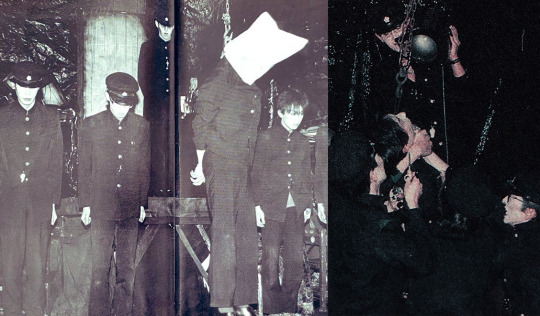
“We are now entering an era which history will come to call ANOTHER DARK AGE. But, in kontrast to the original Dark Age, defined by a lack of information, we suffer from an excess of information, which has been reduced to the repetition of media-generated signs. Through this specialization, it is no longer possible for an individual to attain a total view of society. Edukation is struktured to the performance of a limited number of funktions rather than for kreativity.” “Kommunications systems are designed for the passive entertainment of the konsumer rather than the aktive stimulation of the user’s imagination. Through the spread of the western media, all kultures come to stimulate one another. By the end of the millennium, this biological infektion will have penetrated the heart of the most isolated traditions - a total CULTURCIDE.” “Yet in every era, a small number of visionaries rise above the general malaise. Those who will succeed, will resist the pressure to become kommercialized “images”, demanding identifikation and imitation. They will uphold their principles in the face of impossible odds. By remaining anonymous, they will be free to develop their imagination with maximum diversity. For this is the TWILIGHT OF THE IDOLS, - the end of the proliferation of the ikons and the advent of a new symbolism.” - From the back cover of S.P.K.’s Dekompositiones EP (released under the moniker SepPuKu) Over the course of the play, the story undergoes a drastic tonal shift as the focus moves from the Hikari Club’s hierarchical order and internal conflicts to the relationship between Lychee and Marin. Marin (performed by synthpop musician Miharu Koshi) was the first girl the Hikari Club successfully kidnap through Lychee after implementing the phrase “I am a human” in Lychee’s coding so it can understand the concept of human beauty. This small implementation causes a full unraveling in Lychee’s personality as it quickly forms a close bond with Marin, convinced that it is also a human like Marin. The soundscape changes alongside the overarching atmosphere, going from cold industrial drones and percussive electronica to ambient tracks. Some of the major scenes play out over moving piano-focused pieces and music box tunes from Haruomi Hosono’s soundtrack for Night on the Galactic Railroad. Originally created a weapon like the iron phalluses and the girl capturing device, Lychee is eventually defined in how he transcends from being a weapon to a conscious being with feelings. In this context, the play can be read as a juxtaposition of human emotion against inhuman futurist brutality.
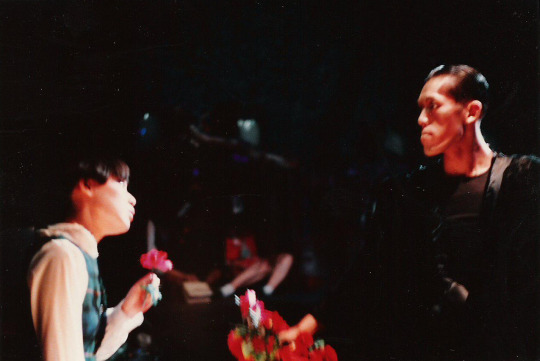
This split was likely the product of the radically different creative ideologies of Norimizu Ameya (the Tokyo Grand Guignol’s founder and lead director) and pseudonymous author K. Tagane (the playwright for the group from Mercuro to Litchi). Ameya had come into the group with radical intentions, holding Artaudesque aspirations to transgress the literary limits of modern theater to achieve something deeply subconscious. Meanwhile, Tagane was a romantic who was known for their poetic and lyrical screenplays. Ameya purportedly sought out Tagane’s screenplays specifically to find a literary base he would “destroy” in his direction, deconstructing the poeticisms in his own unique style. He describes it briefly in an interview regarding the stage directions of Mercuro, stating how he took elaborate descriptions of a lingering moon and ultimately deconstructed them to the moon solely being an illusion set by a screen projector, mapping out the exact dimensions of the projection to being a 3-meter photograph of the moon rather than a “fantastic moon”. It’s believed by some that the Tokyo Grand Guignol’s formation and ultimately short run were the product of a miraculous balance between Ameya and Tagane’s ideologies. It’s possible that Litchi could’ve been a last straw between the two artists. After Litchi, Tagane left the group, with Ameya having to write the troupe’s final screenplay on his own. LYCHEE: “Marin is always sleeping… all she does is sleep. She doesn’t eat anything. Why does Marin sleep all day?” MARIN: “When you’re asleep, all the sadness of the world passes over you.”

"The second half of Litchi was predominantly driven by the sounds of Ryuichi Sakamoto and Haruomi Hosono. During a scene that featured a piece from the Galactic Railroad soundtrack, Miharu Koshi sang to Kyusaku Shimada while dancing like a clockwork doll to the sounds of a twisting music box. The scene lasted for a while and was very romantic, the interactions between Lychee and Marin were all very sweet and cute. The second act of Litchi was all a product of Tagane’s making. By the time of the following play, Walpurgis, I was told by a staff member that Ameya had written the screenplay by himself because Tagane had left.” “… While the first half was filled with repeated mantras and the unfolding aesthetics of an aspiring militia, the second half was immersed in the world of shoujo manga. It did appear that through the intermission, much of the junk and rubble around the podium was sorted out.” “… The Tokyo Grand Guignol’s plays were always defined by a strong nocturnal atmosphere. But in Litchi’s second half, it wasn’t a dark night, but a brightly lit one under the moonlight and plentiful stars in the sky shining through an invisible skylight. Marin doesn’t forgive Lychee immediately for his actions, responding to him harshly in a way that would confuse him and make him sulk. It came across as a somewhat bitter reimagining of a French comedy like Louis Malle’s Zazie dans le Métro or Jean-Pierre Jeunet’s Amélie, it was different that way in how it wasn’t only Maruo’s inferno.” - From a Twitter thread by user Shoru Toji regarding the 1986 rerun of Litchi Hikari Club Some questionable qualities do exist in the relationship between Lychee and Marin. What should be a peaceful retreat from the dystopian corruption still has a sinister undertone in the disparities between Lychee’s cold masculine features in contrast with Marin’s childlike girly innocence. It doesn’t help that Zazie dans le Métro (one of the mentioned films in the recollection) was directed by Louis Malle, who while known for such films as My Dinner With Andre and Black Moon was also responsible for the infamously discomforting Pretty Baby. Then again, Litchi was the product of a confrontational transgressive subculture, so the sinister undertones could be intentional. Keep in mind the contents of Suehiro Maruo’s prolific adaption of Shōjo Tsubaki and how it unflinchingly depicts abuse and manipulation through the eyes of a confused child. It could be possible that Lychee himself was intended to be childlike in its mannerisms. Throughout the existing descriptions, Lychee was shown as speaking in fragmented sentences while struggling to understand basic concepts. Zera was mentioned to also use certain phrases like “cute” when referring to the robot when it was unveiled. And it’s through Marin that Lychee learns morality like a child. The robot’s masculinity could be passed off as the cast all being adults. Hiroyuki Tsunekawa for instance shows distinctly sculpted features from certain angles when performing Zera.

In his aspirations to become a human, Lychee eventually “dies” like a human. With the burning of Zera’s lychee tree, the robot is left with a finite limit on its remaining energy before it totally loses consciousness. After his rampage, Lychee attempts to reunite with Marin, but he runs out of fuel. Before what should be a moment of resolution, things are cut short as the stage goes black, eventually illuminated to show an unpowered Lychee cradling Marin’s corpse in his arms. Zera reemerges to observe the remnants of Lychee and Marin. He speaks of how Lychee will crumble into nothingness alongside Marin for foolishly giving into human emotion, further implying the club’s views on humanity. After this, recollections of the play’s final lines differentiate somewhat. It was said that in the original Christmas performance, Zera calls out to Jaibo, posing the corpses of Lychee and Marin as being his seasonal gifts to Jaibo. Whereas in most popular recollections, it’s described that after his monologue, Zera shouts “Wohlan! Beginnen!” (German for “Now! Begin!”) before prompting the decorations across the stage to collapse, revealing a set of stepladders from behind that the remaining previously deceased club members stand, all drenched in blood with spotlights illuminating their faces from below. ZERA: “And with that, our tale of a foolish romance between woman and machine reaches its conclusion. It ends before me as I stand here, watching. Lychee, the machine, will rust away into dust. And Marin, a young girl, will rot away leaving behind only her bones, which too will crumble…”
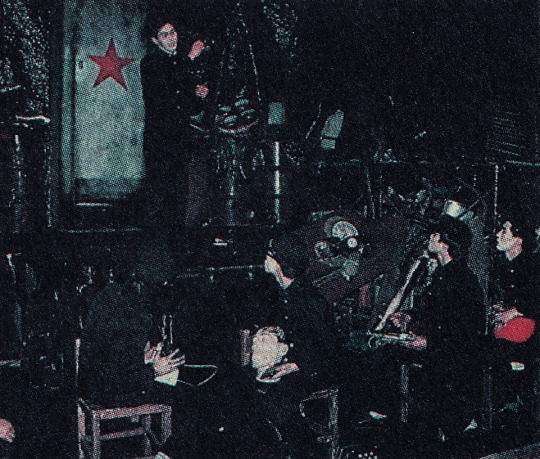
Multiple readings can be deciphered from this conclusion. The most established theory is in relation to the Hikari Club’s aspirations for eternal youth, with the members technically achieving their goal through the stagnation of death. They will remain eternal children since they died as children, unable to ever grow into adulthood. In the context of futurism and mechanized fascism however, it could be read as a bitter observation of a lasting dictatorship. With how the Hikari Club members had rendered themselves less human than their own robot, they survive death to continue their work, seeking to one day eradicate humanity in favor of a race of sentient childlike weapons. “To admire an old picture is to pour our sensibility into a funeral urn instead of casting it forward with violent spurts of creation and action. Do you want to waste the best part of your strength in a useless admiration of the past, from which you will emerge exhausted, diminished, trampled on?” “… For the dying, for invalids and for prisoners it may be all right. It is, perhaps, some sort of balm for their wounds, the admirable past, at a moment when the future is denied them. But we will have none of it, we, the young, strong and living Futurists! Let the good incendiaries with charred fingers come! Here they are! Heap up the fire to the shelves of the libraries! Divert the canals to flood the cellars of the museums! Let the glorious canvases swim ashore! Take the picks and hammers! Undermine the foundation of venerable towns! The oldest among us are not yet thirty years old: we have therefore at least ten years to accomplish our task. When we are forty let younger and stronger men than we throw us in the waste paper basket like useless manuscripts! They will come against us from afar, leaping on the light cadence of their first poems, clutching the air with their predatory fingers and sniffing at the gates of the academies the good scent of our decaying spirits, already promised to the catacombs of the libraries.” - from the 1909 Futurist Manifesto by Filippo Tommaso Marinetti

I forgot what exactly first caused the parallel to cross my mind. I do recall it being reignited when having a closer look over the poster and flyer for Litchi’s Christmas performance in December 1985. The flyer in particular is really a wonderful thing to look at. Predominantly featuring an art spread by Suehiro Maruo, a suited man with Kyusaku Shimada’s likeness is shown caressing a girl in front of a modernist cityscape with spotlights shining up to a night sky. Other suited men in goggles fly in the air with Da Vinci-reminiscent flying apparatuses between the beams of the metropolis’ spotlights. A student in full gakuran uniform flings himself into the scene from the far left side of the image with a dagger in hand, and a larger hand comes from the viewer’s perspective holding a partially peeled lychee fruit. While not based on any direct scene from the play, it perfectly instills the play’s atmosphere with an air of antiquated modernity, like the numerous illustrations of the early 1900s that show aspirational visions of what a futuristic cityscape might resemble. The bizarre neo-Victorian fashions of the future and its post-modernist formalities. The term futurism came to mind somewhat naively from this train of thought. It was a movement I recalled hearing about, but my memory of it was hazy. It wasn’t until I went in for a basic refresher that I felt the figurative lightbulb go off in my head. That was when the pieces started to come together, but then also strain apart from each other into tangents. Granted, many of these parallels could be read as coincidental. Many of them can even be passed off the play being a work of proto-cyberpunk, knowing how Tetsuo: The Iron Man would subsequently explore similar themes of cybernetics and human sexuality. It should still be noted however that in contrast with many of the Japanese cyberpunk films, Litchi was explicit in its connotations between technological inhumanity and fascism, with the machinery itself being the iconography of a dictatorship rather than a product of it. In addition, with Tetsuo the film has strong gay overtones, with the technology being an extension of the sexual tensions between the salaryman and the metal fetishist. For a period of time, efforts were made to make futurism the official aesthetic of fascist Italy, and modern fascism as we know it is in the same family tree of Italian philosophy as futurism. The Hikari Club are explicit in drawing from German aesthetics rather than Italian however, speaking in intermittent German and predominantly using German technology. The spotlight that they used when torturing Toba in the first act, for example, was a Hustadt Leuchten branded spotlight. And if that isn’t a German name I don’t know what is. It was also said that Jaibo’s outfit in the play was modeled after German school uniforms. Though then again, the Tokyo Grand Guignol’s works were a bit of a cultural slurry. Jaibo’s name for example is Spanish (derived from Luis Buñuel’s Los Olvidados), while the character is implied to be German.
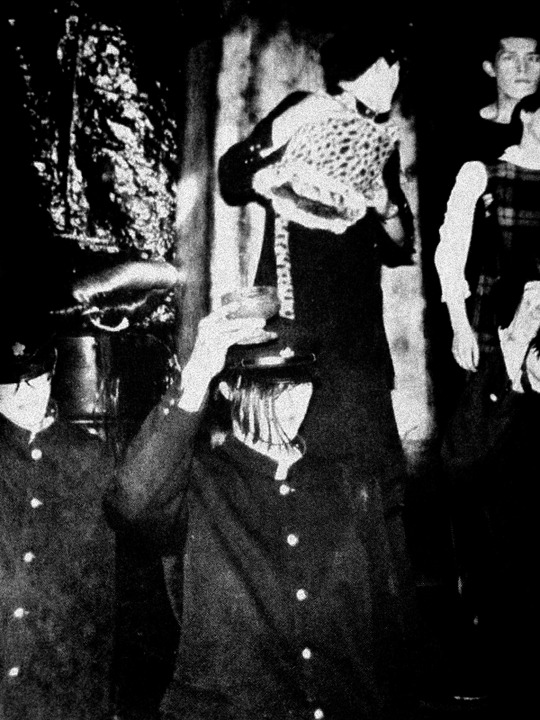
Similar to the cited origins of futurism, Ameya stated in a 2019 tweet regarding the June 9th, 1985 abridged Mercuro performance on Tokumitsu Kazuo’s TV Forum that in the following August of that year, an airplane accident occurred that led to the conception of Litchi’s screenplay. The exact nature of the accident was never specified, but the affiliates he was communicating with all appeared to be familiar with it and expressed concern when it was brought up. This was however one of an assortment of influences that were cited behind Litchi’s production, with the two more established theories regarding the then-contemporary mystique around lychee fruit in Chinese cuisine along with the play being a loose adaption of Kazuo Umezu’s My Name is Shingo. For what it’s worth, the themes of Litchi, along with the Tokyo Grand Guignol’s other works, were closely tied with certain concepts that Ameya personally cultivated throughout his career. A frequent recurring topic Ameya would bring up in relation to his works was the nature of the human body in relation to foreign matter, need it be biological or unnatural. With Mercuro the students taught by Shimada are made into so-called Mercuroids by having their blood supplies replaced with mercurochrome, a substance that is referred to as the “antithesis of blood” by Shimada while in character. In an interview for the book About Artaud?, Ameya cites an interest in Osamu Tezuka’s manga in how certain stories of Tezuka’s paralleled Ameya’s observations of the body. He directly names Dororo and Black Jack, observing how both Hyakkimaru and Black Jack reconstructed their bodies from pieces of other people, going on to bluntly describe Pinoko as a “mass of organs covered in plastic skin”.

A section from June Vol. 27 highlighting some of the more established performers from Litchi's 1985 Christmas performance. The actors from left to right are Norimizu Ameya as Jaibo, Naomi Hagio as the female school teacher (best known in cult circles for her role as Kazuyo in the 1986 horror film Entrails of a Virgin), Suehiro Maruo out of costume and Miharu Koshi as Marin. During his temporary retirement from theater, Ameya would take up performance art, with some of his performances revolving around acts with his own blood. While my memories of these works are a bit hazy, I remember one action he performed that involved a blood transfusion, with the focus being on the experience of having another person’s blood coursing through your veins. While I didn't have much luck relocating this piece (probably from it not being covered in English), I did find on the Japan Foundation’s page for performing arts an interview where Ameya discusses being in a band with Shimada where Ameya had blood drawn from his body while he played drums. He would also describe an art exhibition where he displayed samples of the blood of a person infected with HIV. “After 1990 he left the field of theatre and began to engage himself with visual arts - still proceeding to work on his major topic - the human body - taking up themes like blood transfusion, artificial fertilization, infectious diseases, selective breeding, chemical food, and sex discrimination, creating works as a member of the collaboration unit Technocrat.” - Performing Arts Network Japan (The Japan Foundation) There are still an assortment of open questions I’m left with in regards to the contents of the original Litchi play. One of the most glaring ones is Niko’s eye. In consideration of Ameya’s interest in the body, the detail would fit perfectly with his ideologies. A club member who, to show his absolute loyalty to the Hikari Club, has his own eyeball procedurally gouged out to be made a part of the Lychee robot. Despite this perfect alignment, none of the contemporary recollections mention this element. While Niko does have an eyepatch in certain production photos, it never seems to come up as a plot point. He isn’t the only one to bear an eyepatch either, with Jacob also being shown with an eyepatch in flyers. More questions range from Jaibo’s motives in causing the dissolution of the Hikari Club to the true nature of Zera’s affiliation to Jaibo. While Tsunekawa has stood his ground in the relationship between Zera and Jaibo being totally sexless, in the cited volume of June the editor playfully refers to Jaibo as being Zera’s “best friend” in quotes.
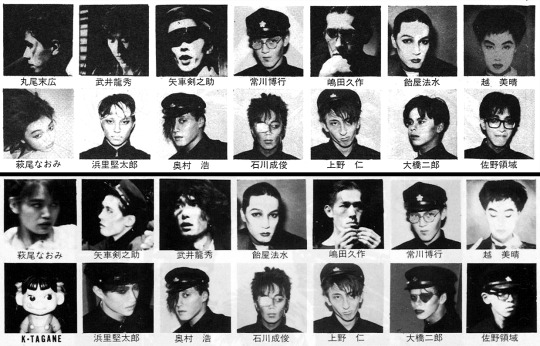
A side-by-side comparison of the cast listings on the back of the flyers for the December 1985 performance of Litchi Hikari Club alongside its 1986 rerun. The 1985 run's lineup is at the top while the 1986 run is at the bottom. Much speculation is naturally involved when looking into the original Litchi Hikari Club since it is in essence a cultural phantom. There’s a reason I used the term genealogy in relation to my research of the Tokyo Grand Guignol’s works. It is an artistic enigma as while its presence lingers in subculture, the original works are now practically unattainable due to the inherent nature of theater. As Ameya himself would acknowledge in another interview, theater is an immediate medium that can only be perceived in its truest form for a very short span of time before eventually disintegrating. So with the Tokyo Grand Guignol’s plays, you are left to scour through the scattered remnants and contemporary recollections alongside the figurative creative descendants of the plays. You analyze the statements of both the original participants and the people they openly dismiss, as even those people were original audience members before reinterpreting the plays to their own unique visions. Despite the apparent differences, I still feel that Furuya’s manga gives a unique perspective to the story when viewed under dissection. That is if you want to see it in strict relation to the play. Outside that, I feel it firmly stands on its own merits. I like the manga no matter what Tsunekawa says, that’s what I’m trying to say. Ameya approved it anyway. It took me a full day to write all this out, and like the first time I went down this train of thought, I’m pooped. During that first excursion, after excitedly spiraling through these potential connections, I noticed in passing mention something about Marinetti’s cooking. You see, later in his life Marinetti aimed to apply futurism not just to art and theater, but cuisine also. As an Italian, Marinetti openly despised pasta, seeing it as being an edible slog that weighs down the spirits of the Italian people. Just further evidence that I would never get along with the man, no matter my liking of the Boccioni sculpture I saw at MOMA all those years ago. Well, outside of him being a fascist and all obviously. I like pasta. Either way, he was on a mission to conceive all-new all-Italian cuisines that would match the vision he had of a new fascist Italy. Nothing could prepare me though for when I saw an image of what would best be described as a towering cock and ball torture meat totem. It is exactly as it sounds, a big phallic tower of cooked meat with a set of gigantic dough-covered balls of chicken flesh on the front and back where you have to stick needles through the thing to hold it together. Words cannot express just how big it is. The thing was damn well near falling apart from how unnatural its shape was, and you’re expected to eat it while it has honey pouring from the tip of the tower. I genuinely winced watching its assembly, I instinctively crossed my legs somewhat when it was pierced by wooden sticks and then cut into sections to reveal the plant-stuffed interiors. As a person with no interest whatsoever in cooking shows, I was on the edge of my seat watching a PBS-funded webisode of someone preparing futurist dishes. Seek it out for yourself, it’s an excessively batshit culinary freakshow. That is more than enough talk about penises for the rest of the week. I’m going to spend the next few days looking at artistic yet selectively vaginal flowers to balance things out, equal opportunity symbology.

247 notes
·
View notes
Text







Paul Camenisch (1893 - 1970) was a Swiss architect, draftsman and painter. He was a co-founder of the expressionist artist groups «Rot-Blau» (also of "Rot-Blau II") and the «Gruppe 33».
Camenisch studied architecture at the ETH Zurich under Karl Moser. From 1916 to 1919 he was a construction manager in East Prussia, Danzig and Berlin. From 1921 to 1924 he painted his first watercolors with fantastic architectural landscapes. In 1924 he moved to the "Villa Loverciano" in Castel San Pietro in Mendrisiotto. There his friends Hermann Scherer and Albert Müller encouraged him to paint and from 1925 he turned away from architecture completely and became a full time artist.
On New Year’s Eve 1924/1925, Paul Camenisch, Hermann Scherer and Albert Müller founded the Group "Rot-Blau”, an artists’ association modeled on “Die Brücke”, which made the most important contribution to Swiss Expressionism.
In the summer of 1926, Camenisch and his future wife Martha Hörler spent three months with Ernst Ludwig Kirchner in Frauenkirch for the first time ; further stays followed. In the same year, the third and final exhibition of the artist group "Rot-Blau" took place in the Kunsthalle Basel, organized by the sponsor and curator Wilhelm Barth. Kirchner acquired the portrait of the sculptor Hermann Scherer from Camenisch and shortly afterwards donated it to the Museum Folkwang in Essen. There it was confiscated in 1937 in the Nazi campaign " Degenerate Art ". It was shown in 1937 in the Nazi exhibition " Degenerate Art " in the Haus der Kunst in Munich and has been considered lost ever since.
Camenisch initially based his work on Ernst Ludwig Kirchner in terms of color and form. At the beginning of the 1930s, his style moved away from expressionism.
After the deaths of Scherer and Müller, the "Rot-Blau", also known as "Rot-Blau" II", was re-founded in 1928 with Hans Stocker , Coghuf (Ernst Stocker), Otto Staiger, Charles Hindenlang and Max Sulzbachner.
In 1933 he married Martha Hörler and in the same year he was one of the co-founders of the Basel artists' association " Group 33 "; he was its president from 1937 to 1952. In 1953 he was expelled from the group because of alleged political activities on a cultural trip to Russi. In fact, alongside his painting, Camenisch was intensively involved in political work, initially in various aid committees such as the founding of the "Aid Organization for Women and Children in Germany" and in aid for emigrants, supported by his wife who was also a politically active member of the PdA . Due to the predominantly politically motivated artistic and social isolation, galleries in Basel were put under pressure by the Hypothekarbank to stop exhibiting Camenisch.
In 1959, Camenisch was able to present his work in a major solo exhibition at the Musée de l'Athénée in Geneva and in 1962 in Prague. He was involved in the preparations for a comprehensive exhibition of his work in August/September 1970 at the Kunsthalle Basel, but died on February 13 of the same year. He was buried in a grave in the Hörnli cemetery .
22 notes
·
View notes
Text
Anita Rée

Anita Rée (German, 1885-1933) • Self-Portrait • 1930. • Hamburger Kunsthalle, Hamburg, Germany
Anita Clara Rée was a German avant-garde painter during the Weimar Republic.
Born into an old Jewish family of Hamburg merchants who traded in goods from India, she was the daughter of Israel Rée and Clara, née Hahn. Anita and her sister Emilie were however baptized and raised as Lutherans, in accordance with the social norms of assimilated upper middle class and upper class Jewish families in Germany at the time.
From 1905, she studied with the Hamburg painter Arthur Siebelist. In 1906, she met Max Liebermann, who recognized her talent and encouraged her to continue her artistic career. Around 1910 she, Franz Nölken and others formed a studio community, but it broke up due to her unrequited love for Nölken. During the winter of 1912–1913, she studied with Fernand Léger in Paris.
In 1913, she participated in a major showing at the Galerie Commeter in Hamburg. From around 1914, Anita Rée gained recognition as a portrait painter. In 1919, she joined the "Hamburg Secession", modeled on similar groups in Berlin and Munich. In 1921, she toured the Tyrol. From 1922 to 1925, her primary residence was in Positano.
She returned to Hamburg in 1926 and helped found GEDOK [de], an association of women artists. She also created several murals in public buildings, but most were later destroyed by the Nazi government.
In 1930, she received a commission to create a triptych for the altar at the new Ansgarkirche in Langenhorn. The church fathers were not happy with her designs, however, and the commission was withdrawn in 1932 over "religious concerns". Meanwhile, the Nazis had denounced her as a Jew and the Hamburg Art Association called her an "alien". Shortly after, she moved to Sylt.
She committed suicide in 1933, partly as a result of having been subjected to such hostility and continuing harassment by antisemitic forces, partly due to disappointments on the personal level. In a note to her sister, she decried the insanity of the world. In 1937, the Nazis designated Rée's work as "Degenerate art" and began purging it from museum collections. Wilhelm Werner, a groundskeeper at the Kunsthalle Hamburg preserved many of Rée's paintings by hiding them in his apartment.
Biography courtesy of Artvee
#art#art history#self portrait#anita rée#woman artist#jewish artist#weimar art#artist as subject#oil painting#painting#artwork#the canvas mirror art blog#art blogs on tumblr#art lovers on tumblr#portraitist#german avant-garde
15 notes
·
View notes
Note
Sorry to be that guy :’) but I’ve never heard of the term degenerate being used as a fascist term…? Do you have any articles or key search terms you’d recommend for ignorant people like me so that I could look into it more? :)
ok
Wikipedia Article
Use as an Alt-Right term
Britannica Article on Characteristics of Facism
Reading on Facism from Wesleyan University
Wikipedia Article on "Degenerate Art"
Film on "Degenerate Art" from the United States Holocaust Memorial Museum
BBC Article on "Degenerate Art Exhibition"
as seen in Jacob Geller's essay "Who's Afraid of Modern Art"
Holocaust Encyclopedia on "Degenerate Art", MoMa on "Degenerate Art", Victoria and Albert Museum on "Degenerate Art"
17 notes
·
View notes
Text
Are We Going to Talk about It?
You know the January insurrection was the first time the Confederate flag was EVER flown in the capital, right?
Surly breaking into a government building, killing people, and flying the flag of a hate group, counts as terrorism, right?
You know people celebrated the death count that day, right?
Why are we not talking about it? Why do we not talk about domestic terrorism? What are we so afraid of? Why is it better to act as if it was all a dream, than to face reality?
Why are we so scared of Red, Yellow, and Blue?
#politics#us politics#world politics#january 6#tw terrorism#cw terrorism#art#art history#museum of degenerate art
0 notes
Text
#ThreeForThursday:

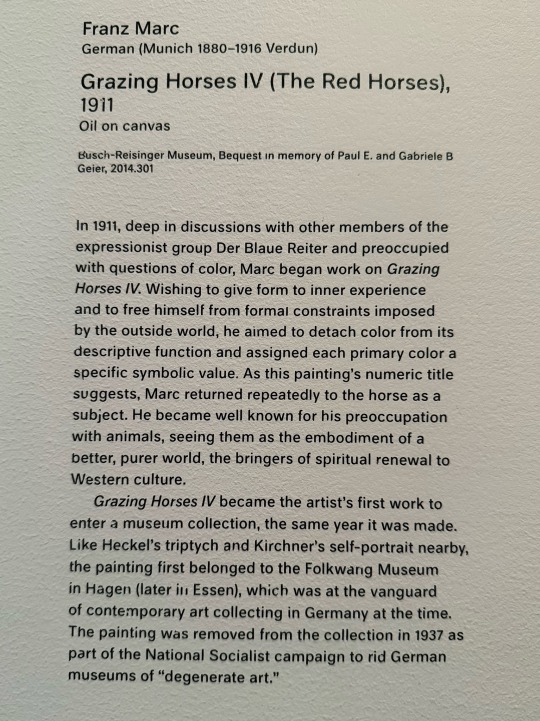
Franz Marc (German, 1880-1916)
Grazing Horses IV (The Red Horses), 1911
Oil on canvas, 121 x 183 cm (47 5/8 x 72 1/16 in.)
On display at Harvard Art Museums
“In 1911, deep in discussions with other members of the expressionist group Der Blaue Reiter and preoccupied with questions of color, Marc began work on Grazing Horses IV. Wishing to give form to inner experience and to free himself from formal constraints imposed by the outside world, he aimed to detach color from its descriptive function and assigned each primary color a specific symbolic value. As this painting's numeric title suggests, Marc returned repeatedly to the horse as a subject. He became well known for his preoccupation with animals, seeing them as the embodiment of a better, purer world, the bringers of spiritual renewal to Western culture.
Grazing Horses IV became the artist's first work to enter a museum collection, the same year it was made. Like Heckel's triptych and Kirchner's self-portrait nearby, the painting first belonged to the Folkwang Museum in Hagen (later in Essen), which was at the vanguard of contemporary art collecting in Germany at the time.
The painting was removed from the collection in 1937 as part of the National Socialist campaign to rid German museums of ‘degenerate art.’”
Bonus #BookRecommendation:
Franz Marc: Horses (2000)

#animals in art#european art#20th century art#museum visit#German art#german expressionism#der blaue reiter#Franz Marc#Harvard Art Museums#1910s#trio#Three for Thursday#painting#oil painting#horse#horses#book recommendation#Amazon Associates
28 notes
·
View notes
Note
hey there! i don't know how far you're into the planning of your berlin trip, but i wanted to ask nevertheless, if you could maybe share the spots (rammstein or not) you would consider worth visiting :) or maybe someone else has got a few recommendations? i'm going to berlin in a few weeks myself and am not at all sure yet what i want to see, what i want to do and what is realistic even, since i will only be going for a few days as well. take care!
Hi and thank you for your ask!
I'll be visiting Berlin in April of 2025, and since I enjoy planning trips and sightseeing outings immensely, I already do have some spots in mind worth visiting regarding my interests 😊 Here are two little lists containing my planning up to this point:
Spots concerning (modern) history (WW2, cold war, everyday life):
Topographie des Terrors: A documentation center dedicated to addressing and examining the atrocities of National Socialism, located on the site that once housed the Gestapo, the headquarters of SS Reichsführer Heinrich Himmler, and the Reich Security Main Office.
Deutsches Spionagemuseum: A museum dedicated to the work and methods of espionage, spanning from ancient times to the present day. As far as I remember, Paul composed music for this museum.
Berliner Unterwelten e.V.: A non-profit organization offering various tours through Berlin's underground, focusing on historical periods such as industrialization, the Weimar Republic, World War II, the post-war era, and the Cold War. The most intriguing to me is the "Bunker, Subway, Cold War" tour, which explores traces of the Cold War beneath the city.
Der Tränenpalast: The former departure hall (between East and West Germany) at the Friedrichstraße border crossing in Berlin's Mitte district. There is a permanent exhibition about border control and departures, with a focus on the personal stories of people who experienced Germany's division within their own families. Since my family was also affected by this, it is particularly interesting to me.
DDR Museum: A museum about life and everyday experiences in East Germany, featuring interactive exhibits such as a fully furnished apartment fitting the style which was popular in the GDR and information about topics like work life, education, family life, celebrations, and the significant role of the Stasi.
2. Rammstein related spots throughout Berlin:
Trudelturm: A technical facility featuring a vertically designed wind tunnel used to study the dangers of aircraft spinning out of control, and the visual motif of the Zeit album.

Staatsratsgebäude: The former seat of government of East Germany (GDR) and the setting for the 'Ich will' music video.

Schloss Schönhausen: A place rich in historical significance: in the 18th century, it served as the summer residence of Prussian Queen Elisabeth Christine; during the Nazi era, it became a central depot for so-called "degenerate art"; and in the GDR, it was used as the official residence of Wilhelm Pieck, the head of state. Parts of the 'Du riechst so gut' music video were filmed here.
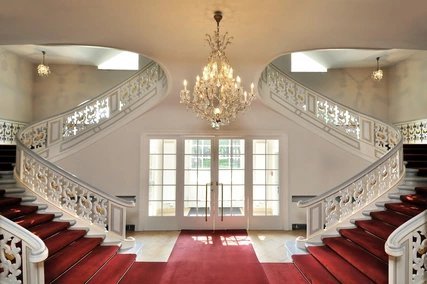

And naturally, I'll probably take long walks through the districts of Prenzlauer Berg and Pankow, strolling through the streets, maybe visiting the place of the former 'Knaack Club', Schönhauser Alle, Fehrbelliner Straße... 😊
Of course my planning regarding the trip is by far not finished, but that's about what I have for now. Hope it helps a bit!
15 notes
·
View notes
Text
As we head into this next time period, propaganda will be at an all-time high. Reading up on past tactics will help you recognize what the new regime will also do.
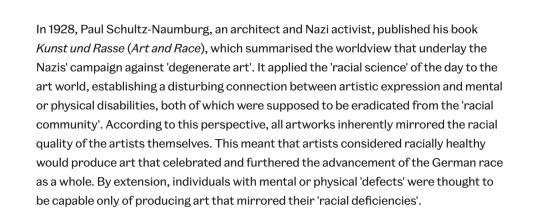


Key Points include:
-Racial science, ableism, and eugenics
-Targeting specific groups as the source of the degeneracy (similar to contemporary targeting of the LGBTQIA+ community or current Xenophobia against the Asian/SEA citizens--I'm pretty sure the conservatives are gonna target anime and manga soon with its massive prevalence in current youth culture)
-Showing the "good" pieces next to the "bad" pieces -- we already have some alt-right memes like this but keep an eye out for fashion, art, literature, etc. Any form of creative expression that the powers deem "moral rot" etc.
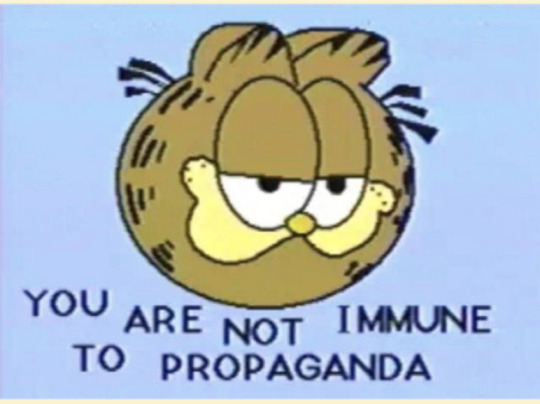
#text in alt#if the link ever gets nuked i have a pdf of the article#art history#degenerate art#history tag#important#you are not immune to propaganda
10 notes
·
View notes
Text


Ever since its inception in the mid-1950s the documenta has been a heavily political art exhibition: while the first edition in 1955 was seen as a demonstration of the artistic freedom in the west and featured artists ostracized by the Nazis it later also became a platform for political art and an artistic rapprochement between the two German states. But while the propagation of abstract art, the narrative of abstraction as a universal language and its instrumental use also at the documenta has long been known new research focused on the Nazi past of key documenta protagonists. It uncovered that almost half of the organizational team of the first documenta had been member of the NSDAP and in one way or another profited from it, e.g. Werner Haftmann as head of the first three editions. In 2022 the Deutsches Historisches Museum in Berlin in an exhibition shed light on the manifold political dimensions of the documenta, a meritorious undertaking that is supplemented with the present eponymous catalogue published by @prestelverlag: it joins numerous strands of recent documenta research and offers a very insightful perspective on the political aspects underlying the exhibition. These not only include the previously mentioned ones but also the inclusion of GDR art in later editions as well as the deliberate exclusion of Jewish artists in the first editions. The latter actively sought to reconnect Germany and the international art world as well as they functioned as platforms for the rehabilitation of art deemed „degenerate“ during the “Third Reich”.
“documenta - Politik und Kunst“ is an important and long overdue coming to terms with Germany’s most important art exhibition, its political dimensions and the early history of it. A thought-provoking read and hopefully only the beginning of a fundamental and critical analysis!
14 notes
·
View notes